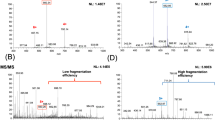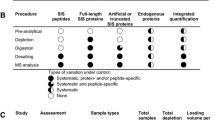Abstract
Heat shock protein 90α (HSP90α) has been regarded as an important indicator for judging tumor metastasis and prognosis due to its significant upregulation in various tumors. Therefore, the accurate quantification of HSP90α is of great significance for clinical diagnosis and therapy of cancers. However, the lack of HSP90α certified reference material (CRM) leads to the accuracy and consistency of quantification methods not being effectively evaluated. Besides, quantitative results without traceability make comparisons between different studies difficult. In this study, an HSP90α solution CRM was developed from the recombinant protein raw material. The recombinant protein is a dimer, and the purity of the CRM candidate reached 96.71%. Both amino acid analysis-isotope dilution mass spectrometry (AAA-IDMS) and unique peptide analysis-isotope dilution mass spectrometry (UPA-IDMS) were performed to measure the content of HSP90α in the solution CRM candidate, and the certified value was assessed to be 66.2 ± 8.8 µg/g. Good homogeneity of the CRM was identified, and the stability examination suggested that the CRM was stable for at least 4 months at − 80 °C and for 7 days at 4 °C. With traceability to SI unit (kg), this CRM has potential to help establish a metrological traceability chain for quantification of HSP90α, which will make the quantification results standardized and comparable regardless of the quantitative methods.





Similar content being viewed by others
References
Zheng R, Zhang S, Zeng H, et al. Cancer incidence and mortality in China. J Natl Cancer Center. 2016;2(2022):1–9. https://doi.org/10.1016/j.jncc.2022.02.002.
Omage J, Easterday E, Rumph J, et al. Cancer diagnostics and early detection using electrochemical aptasensors. Micromachines. 2022;13:522. https://doi.org/10.3390/mi13040522.
Liu W, Li J, Zhang P, et al. A novel pan-cancer biomarker plasma heat shock protein 90alpha and its diagnosis determinants in clinic. Cancer Sci. 2019;110:2941–59. https://doi.org/10.1111/cas.14143.
Buchner J, Hsp90 & Co. - a holding for folding. Trends Biochem Sci. 1999;24:136–141. https://doi.org/10.1016/s0968-0004(99)01373-0
Ni T, Duan X, Wang M, et al. Alkaloid derivative ION-31a inhibits breast cancer metastasis and angiogenesis by targeting HSP90α. Bioorg Chem. 2021;115:105201. https://doi.org/10.1016/j.bioorg.2021.105201.
Hou Q, Chen S, An Q, et al. Extracellular Hsp90α promotes tumor lymphangiogenesis and lymph node metastasis in breast cancer. Int J Mol Sci. 2021;22:7747. https://doi.org/10.3390/ijms22147747.
Alexiou G, Karamoutsios A, Lallas G, et al. Expression of heat shock proteins in brain tumors. Turk Neurosurg. 2014;24:745–9. https://doi.org/10.5137/1019-5149.jtn.9852-13.0.
Fu Y, Xu X, Huang D, et al. Plasma heat shock protein 90alpha as a biomarker for the diagnosis of liver cancer: an official, large-scale, and multicenter clinical trial. EBioMedicine. 2017;24:56–63. https://doi.org/10.1016/j.ebiom.2017.09.007.
Song X, Wang X, Zhuo W, et al. The regulatory mechanism of extracellular Hsp90α on matrix metalloproteinase-2 processing and tumor angiogenesis. J Biol Chem. 2010;285:40039–49. https://doi.org/10.1074/jbc.M110.181941.
Wang X, Zhuo W, Fu Y, et al. The regulatory mechanism of Hsp90α secretion and its function in tumor malignancy. PNAS. 2009;106:21288–212193. https://doi.org/10.1073/pnas.0908151106.
Trepel J, Mollapour M, Giaccone G, et al. Targeting the dynamic HSP90 complex in cancer. Nat Rev Cancer. 2010;10:537–49. https://doi.org/10.1038/nrc2887.
El-Shemi A, Refaat B, Kensara O, et al. Paricalcitol enhances the chemopreventive efficacy of 5-fluorouracil on an intermediate-term model of azoxymethane-induced colorectal tumors in rats. Cancer Prev Res. 2016;9:491–501. https://doi.org/10.1158/1940-6207.capr-15-043.
Qi J, Liu Y, Yang P, et al. Heat shock protein 90 inhibition by 17-dimethylaminoethylamino-17-demethoxygeldanamycin protects blood-brain barrier integrity in cerebral ischemic stroke. Am J Transl Res. 2015;7:1826–37.
Zhai R, Chu Z, Zhu M, et al. Lattice-like 3-dimensional DNA nanostructure-based bioseparation strategy for highly accurate quantification of low-abundance cancer biomarker via mass spectrometry. Chem Eng J. 2022;428:130938. https://doi.org/10.1016/j.cej.2021.130938.
Yan J, Wang M, Yang M, et al. Study of SI-traceable purity assessment of bovine lactoferrin using mass balance approach and amino acid-based isotope dilution liquid chromatography-mass spectrometry. Food Chem. 2022;385:132674. https://doi.org/10.1016/j.foodchem.2022.132674.
Josephs R, Stoppacher N, Daireaux A, et al. State-of-the-art and trends for the SI traceable value assignment of the purity of peptides using the model compound angiotensin I, TrAC. Trends Anal Chem. 2018;101:108–19. https://doi.org/10.1016/j.trac.2017.09.026.
Ishikawa K, Hanari N, Shimizu Y, et al. Mass balance method for purity assay of phthalic acid esters: development of primary reference materials as traceability sources in the Japan Calibration Service System, Accredit. Qual Assur. 2011;16:311–22. https://doi.org/10.1007/s00769-011-0767-0.
Westwood S, Josephs R, Choteau T, et al. CCQM-K55.b (Aldrin) Final report: October 2012 CCQM-K55.b Key comparison on the characterization of organic substances for chemical purity. Metrologia. 2012;49:08014. https://doi.org/10.1088/0026-1394/49/1A/08014.
Wang X, Wu L, Huang Y, et al. Development of a human insulin certified reference material with SI-traceable purity. Anal Bioanal Chem. 2022;414:3443–57. https://doi.org/10.1007/s00216-011-4994-3.
Wu L, Yang B, Bi J, et al. Development of bovine serum albumin certified reference material. Anal Bioanal Chem. 2011;400:3443–9. https://doi.org/10.1007/s00216-011-4994-3.
Feng L, Huo Z, Xiong J, et al. Certification of amyloid-beta (Aβ) certified reference materials by amino acid-based isotope dilution high-performance liquid chromatography mass spectrometry and sulfur-based high-performance liquid chromatography isotope dilution inductively coupled plasma mass spectrometry. Anal Chem. 2020;92:13229–37. https://doi.org/10.1021/acs.analchem.0c02381.
Tran T, Kim J, Rosli N, et al. Certification and stability assessment of recombinant human growth hormone as a certified reference material for protein quantification. J Chromatogr B. 2019;1126–1127:121732. https://doi.org/10.1016/j.jchromb.2019.121732.
Hu T, Wu L, Sun X, et al. Comparative study on quantitation of human myoglobin by both isotope dilution mass spectrometry and surface plasmon resonance based on calibration-free analysis. Anal Bioanal Chem. 2020;412:2777–84.
Kato M, Kinumi T, Yoshioka M, et al. Development of C-reactive protein certified reference material NMIJ CRM 6201-b: optimization of a hydrolysis process to improve the accuracy of amino acid analysis. Anal Bioanal Chem. 2015;407:3137–46. https://doi.org/10.1007/s00216-014-8190-0.
Kinumi T, Goto M, Eyama S, et al. Development of SI-traceable C-peptide certified reference material NMIJ CRM 6901-a using isotope-dilution mass spectrometry-based amino acid analyses. Anal Bioanal Chem. 2012;404:13–21. https://doi.org/10.1007/s00216-012-6097-1.
Jeong J, Lim H, Kim S, et al. Quantification of human growth hormone by amino acid composition analysis using isotope dilution liquid-chromatography tandem mass spectrometry. J Chromatogr A. 2011;1218:6596–602. https://doi.org/10.1016/j.chroma.2011.07.053.
Liu J, Zhu W, Sun H, et al. Development of a primary reference material of natural C-reactive protein: verification of its natural pentameric structure and certification by two isotope dilution mass spectrometry. Anal Methods. 2021;13:626–35. https://doi.org/10.1039/d0ay02289f.
Bi J, Wu L, Yang B, et al. Hemoglobin A1c certified reference material by liquid chromatography isotope dilution mass spectrometry. Anal Bioanal Chem. 2012;403:549–54. https://doi.org/10.1007/s00216-012-5834-9.
Pritchard C, Groves K, Biesenbruch S, et al. Quantification of human growth hormone in serum with a labeled protein as an internal standard: essential considerations. Anal Chem. 2014;86:6525–32. https://doi.org/10.1021/ac501032q.
Josephs R, Martos G, Li M, et al. Establishment of measurement traceability for peptide and protein quantification through rigorous purity assessment-a review. Metrologia. 2019;56:044006.
Arsene C, Ohlendorf R, Burkitt W, et al. Protein quantification by isotope dilution mass spectrometry of proteolytic fragments: cleavage rate and accuracy. Anal Chem. 2008;80:4154–60. https://doi.org/10.1021/ac7024738.
Funding
This work was funded by the National Key Research and Development Program of China (No.2022YFF0608401), National Natural Science Foundation of China (No.21927812), and Fundamental Research Funds of the National Institute of Metrology (AKYZD1907, AKYZD2111, AKYCX2211).
Author information
Authors and Affiliations
Corresponding author
Ethics declarations
Conflict of interest
The authors declare no competing interests.
Additional information
Publisher's Note
Springer Nature remains neutral with regard to jurisdictional claims in published maps and institutional affiliations.
Supplementary Information
Below is the link to the electronic supplementary material.
Rights and permissions
Springer Nature or its licensor (e.g. a society or other partner) holds exclusive rights to this article under a publishing agreement with the author(s) or other rightsholder(s); author self-archiving of the accepted manuscript version of this article is solely governed by the terms of such publishing agreement and applicable law.
About this article
Cite this article
Zhu, M., Li, J., Chu, Z. et al. Development of cancer biomarker heat shock protein 90α certified reference material using two different isotope dilution mass spectrometry techniques. Anal Bioanal Chem 416, 913–923 (2024). https://doi.org/10.1007/s00216-023-05079-7
Received:
Revised:
Accepted:
Published:
Issue Date:
DOI: https://doi.org/10.1007/s00216-023-05079-7




